One way to look at cuisine is the interface between what foods are available and the cultures of the people who live there. We get a fascinating case study in the foods of Israel, a young country in an ancient land, with most of its population zero to two generations removed from some other place, whether near or very far. Israeli food is very much not what we think of in the U.S. as "Jewish food," for a few good reasons. I could get into ethnography and census counts, but this is a food blog, so just think to yourself whether matzo ball soup and brisket roasts sound good in a hot environment. Frankly, I don't blame Israelis, including those of Ashkenazi descent, for ditching the food of a poor people in a cold climate with short growing seasons, and instead preferring the abundance of the Mediterranean. There's a reason the Garden of Eden is placed somewhere around there! (Incongruously, Israel has also developed a far less holy snack-food industry.)

Rather, much of the food in Israel comes from the Mizrahi, which essentially means Jews from places that aren't culturally European, including North Africa, the Middle East, and central Asia — depending on who you ask this includes the Sephardim, those whose lineage goes back to Spain. It's unclear to me whether such staples of the Israeli table like hummus, falafel, and shawarma come from these immigrants or were borrowed (or appropriated, depending on your view) from the Palestinians; if anything, my guess is that both factors reinforced each other. That said, the Mizrahim brought other foods, like kibbe soup from Iraq, and the fish dish you'll see later. (Speaking of Palestine, as it's a permanent observing state of the UN, it'll get its own meal later on.) The last notable group is Ethiopian, though it doesn't seem like they have a huge impact on the standard Israeli table.
I owe a huge debt of gratitude to Sarah, my buddy from high school, who now lives and works in Israel. She's an assiduous follower of the blog, and was a tremendous help in sorting through the menu, steering me in the right direction (turns out Israelis don't really make falafel at home!), and pointing out things I may never have come across because they're almost too obvious to anyone who knows the culture (minty lemonade!).

Our guests for the evening were Martyna, Russell, Jessica, Miriam, and Rob!
Limonana | Minty lemonade | Recipe
It's so goofy as to sound apocryphal: this most refreshing of drinks is not only an invention from within the past 25 years, but it came about as the invented subject of an ad campaign meant to prove the value of out-of-home ads (think sides of buses). Apparently enough people were enticed by the promise of a minty lemonade with a catchy name that they started asking for it at restaurants, who pretty quickly figured out how to make it.
Whenever and however it was invented, it's a shock this beverage isn't found anywhere in the world it gets hot. Tart lemon is refreshing, cooling mint is refreshing, and the addition of sugar and seltzer make them a delight to drink. In this version I made a simple syrup with mint, but you could just as easily muddle mint in the glass.
Sarah made it clear that to be a real Israeli summertime event, we ought to also mix arak, an anise liqueur similar to raki or ouzo, with grapefruit juice. As she had warned, we found it pretty vile.
Hummus | Chickpea dip | Recipe
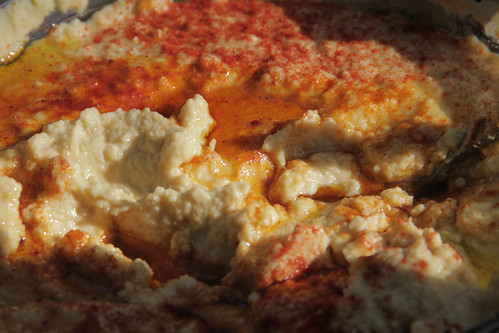
While time-consuming, it's easy and cheap to make hummus from scratch. It takes an overnight soak and several hours of simmering, but the final step is a mere blitz in the food processor and you've got your own fluffy, creamy dip that's as garlicky, salty, tangy, or oily as you want it. For those of us who are, uh, sensitive to garbanzos, you may find that when you give the a long soak and a slow simmer, they're a lot more digestible than their commercially prepared counterpart.
Pita | Flatbread | Recipe
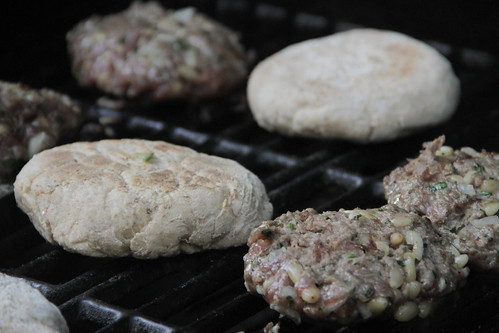
Respectable bakers say that when it comes to normal loaves of bread, bad bread should be eaten hot to mask the lack of flavor, and good bread should be allowed to sit for a bit. But I really like hot bread, so flatbreads allow me to indulge my taste and maintain my amateur-baker pride. Flatbreads are also generally pretty quick and easy to make, the only annoying part being frequently bending over and pulling things into and out of a hot oven. My trick is, whenever possible, to make flatbreads on a griddle on the barbecue, which makes access so much easier.
Unlike the thin and rather sparse pitas we most often see here, Israeli pitas are thicker and spongier. I found I got the right thickness by putting a ball of dough on a plate with slightly raised sides and using a rolling pin along the edges of the plate, making for about a half-inch-thick piece of dough. (I use a horizontally-grooved hand-carved chapati roller I bought for fifty cents at a Mumbai antique shop. You could also use a wine bottle.) Too much sauce soaks right through a normal pita, while this thicker variety is well-suited for sopping up all manner of dip and sauce, or for making your own little sandwich with. Yum.
Salat yerakot | Chopped salad
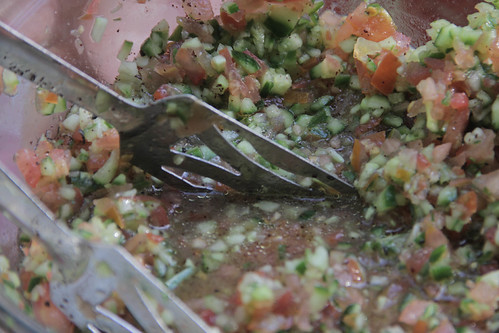
It's really nothing more than tomato and cucumber with sumac, lemon juice, and olive oil, the sort of thing that's eaten pretty much anywhere those ingredients grow. But what makes it Israeli is how incredibly finely chopped everything is. Apparently it's a point of honor of Israeli chefs. I found it made things really watery as you can see, as every stroke of the knife squishes more juice from the tomato — was I supposed to drain some of it?
Chraime | White fish in spicy tomato sauce | Recipe

We can thank the Sephardic Jews of North Africa, many of whom emigrated to Israel, for this easy, simple, yet really tasty dish. The flavors play off so well, the tang and spice of the sauce with the oily-sweet, fleshy fish. And it's so easy to throw together: throw together ingredients you probably have on hand (including that humblest of staples, tomato paste), pop in whatever firm fish you happen to find (the recipe calls for sea bass but I had an easier time coming by swordfish thanks to Trader Joe's), and you're done. Tasty dinner in 20 minutes.
Yerakot kluim im daloreet, krooveet, ve'batzal adom | Roasted vegetables with tahini sauce | Recipe
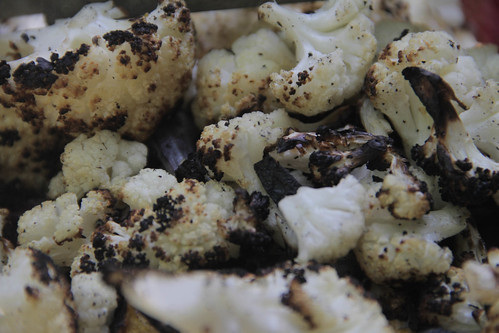
Sarah made it clear that adding cauliflower to the meal would lend a real sense of authenticity, and that Israelis love their roasted veggies, so that's how I made the cauliflower, along with butternut squash and red onions. Instead of roasting in the oven, I threw everything in a basket on the grill. The veggies got moderately charred, but the crowd didn't seem to mind, it all got gobbled up.
Kebabim | Ground lamb with pine nuts and tahini sauce | Recipe
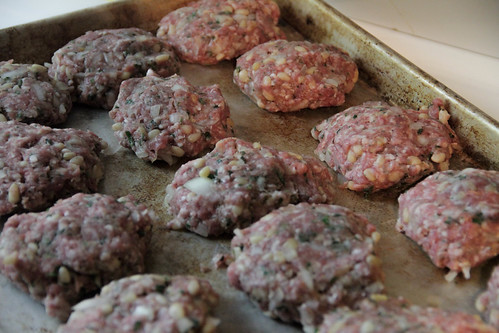
In Israel, kebab doesn't mean meat chunks on a skewer, or a big ol' spit (that's schwarma in Israel, of course), but rather spiced ground lamb patties. Pine nuts add a bit of crunch and the mint is a refreshing balance to the rich lamb. I grilled them like hamburgers, then we doused them in a tahini sauce. They also worked well as a sandwich inside the pita. I ended up with way too much of the meat, which I then froze raw for future meals.
Yerushalmi kugel | Peppery caramel casserole | Recipe
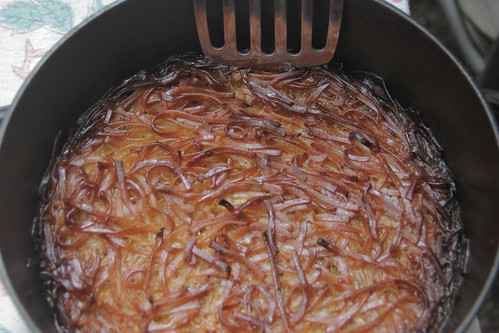
This is one of the few foods I found that can be called historically Israeli, as in, invented by a Jewish community living there before the creation of the state. It's a curious dish, a noodle casserole that blends an oily sweet caramel with fresh cracked pepper, and bound together with eggs. With a long, slow bake, the top and edges get good and crispy, and the inside stays moist. Is this a dessert, a snack, or a light meal? It could be any of that.
Rugelach | Chocolate-walnut-jam rolled cookies | Recipe

For years I've heard stories of my ancestor, Fannie Danab, who was such a good cook that she never taught anyone her techniques, since she didn't want anyone to be a slave to the kitchen like she was. All the same, my grandmother worked to replicate her recipe for rugelach, the crispy little rolled-up cookies that, along with schniztel, are one of the few Ashkenazi (Eastern European) Jewish foods to have become firmly implanted in Israel. The recipe here is, according to my mom, pretty close to what my grandmother would make, so here you have it, third-hand.
The secret to the flaky dough is cream cheese and of course butter; I decided to keep this meal kosher, so it was Tofutti and margarine here. I rolled out rounds (it's thankfully a pretty forgiving dough), spread out a really tasty strawberry-raspberry jam, sprinkled with chocolate and walnuts (not hazlenuts, because I used what I had), sliced into wedges, and merrily rolled them up.